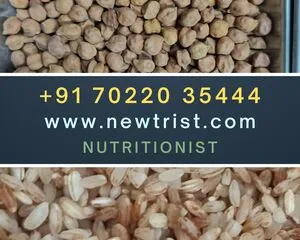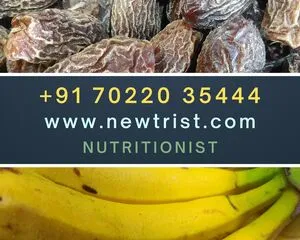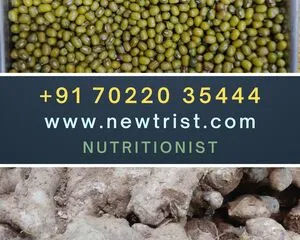Newtrist Nutritionist Vitiligo diet plan consists of foods such as leafy greens, fruits, vegetables, chickpeas, tubers, and root vegetables. Foods rich in folic acid should be an essential part of daily diet as the body cannot synthesize vitamin B9.
- Early morning drink @ 6:30 am: Ginger juice
- Breakfast @ 9 am: Moong dal cheela with carrot/methi chutney
- Mid-morning meal @ 11 am: Banana-dates-shredded coconut salad
- Lunch @ 1 pm: Brown rice with lauki dal and ghee and radish sabzi
- Evening snack @ 4 pm: Boiled chickpea-corn chat
- Dinner @ 7 pm: Dahlia upma with vegetables and cucumber salad
Consult 19 years experienced Chief Nutritionist Vasanthi for expert advice and a personalized diet plan. In-person consultation at HSR, Koramangala, Bellandur, Haralur, and video consultation across India.
- Consultation INR 750
- 1 Week personalized diet plan INR 2000
- 1 Month personalized diet plan INR 4000
- 3 Months personalized diet plan INR 9000

Table of Contents
What is Vitiligo?
Vitiligo is a pigmentary disorder that causes loss of skin color or pigmentation over the face, hands, feet, and fingers due to the destruction of melanocytes. The lack of melanin pigment causes the disease. A deficiency of vitamin D is commonly observed in vitiligo patients. Smooth white patches called macules appear on various parts of the body.
Melanocytes are cells in the skin that produces melanin. During this autoimmune condition, the body’s immune system destroys the melanocytes and causes a deficiency of melanin that leads to this disease condition. People with psoriasis, anemia, lupus, Addison’s disease, and thyroid disease are at high risk of vitiligo.
Vitiligo isn’t painful but sunburns are more likely to occur on the patches of the affected skin. Vitiligo may cause skin sensitivity and retinal abnormalities in some people.
What are the symptoms of Vitiligo?
Loss of skin color, premature greying of hair on the scalp, eyebrows, eyelashes, and beard, and loss of color in the tissues of the mucus membrane in the inside of the nose and mouth are some of the symptoms of Vitiligo. The patches may appear in small areas and gradually spread over the whole body.
Sunburns on the affected patches and spots, itchiness in the patches, loss of hearing, and changes in the color of the eyes are some of the common symptoms of vitiligo.
Vitiligo is more prevalent in people with darker skin tones and it may develop at any age. Vitiligo can neither be prevented nor cured but preventive measures can avoid the worsening or spreading of the symptoms.
What are the types of Vitiligo?
The types of vitiligo are
Localized
Generalized
Segmental
Mucosal
Focal
Trichome
Universal
What is Localized vitiligo?
In Localized vitiligo, the patches or spots are limited to certain parts of the body.
What is Generalised vitiligo?
In Generalised vitiligo, the macules appear in various parts of the body. It is the most common type of vitiligo prevalent in patients.
What is Segmental vitiligo?
Segmental vitiligo affects one side of the body such as the hands or the face.
What is Mucosal vitiligo?
Mucosal vitiligo affects the tissues of the mucus membrane in the mouth and genitals.
What is Focal vitiligo?
Focal vitiligo is a rare type of vitiligo where the patches are found in a small area and do not spread for a couple of years.
What is Trichome vitiligo?
Trichome vitiligo is a tricolor vitiligo that causes a bullseye with a white center, followed by an area of light pigmentation, and an area of natural skin color.
What is Universal vitiligo?
Universal vitiligo is a rare type of vitiligo where more than 80% of the skin does not have the pigment.
Vitiligo diet Plan
The vitiligo diet plan should consist of foods rich in vitamin D, proteins, healthy fats, and root vegetables that prevent further progression of the condition. A nutrient-dense diet rich in antioxidants, vitamins, and herbs helps in decreasing the discoloration of the skin and its recurrence.
- Early morning drink @ 6:30 am: Basil tea
- Breakfast @ 9 am: Oats idly with carrot sambar
- Mid-morning meal @ 11 am: Papaya juice with finger millet cookies
- Lunch @ 1 pm: Mixed vegetable quinoa pulav with beetroot chops and a small apple
- Evening snack @ 4 pm: Sprouted moong with roasted peanuts
- Dinner @ 7 pm: Jowar roti with cauliflower sabzi

Foods to avoid with Vitiligo
Foods to avoid with Vitiligo are tea, coffee, canned juices, dairy products, citrus fruits, fish, blueberries, gooseberries, pomegranates, grapes, pears, pickles, tomatoes, wheat products, red meats, processed meats such as sausages, hot dogs, and deli meats, refined foods like white rice, curd, wheat, white bread, pasta, and noodles, fried foods, and sodas.
A diet plan with the restriction of these foods aids in reducing inflammation. Some patients may experience gluten sensitivity for whom limitations of gluten-rich foods are advised.
Pears, blueberries, and certain skin-bleaching creams contain hydroquinone, a depigmenting compound that lowers the production of melanin which makes the white patches more whiter. Sour fruits like lemons, lime, gooseberries, oranges, and grapes contain ascorbic acid that lightens the skin patches and contributes to the worsening of the condition. Sour foods inhibit melanin production due to their acidic nature.
Foods high in saturated fats such as red meats, fast foods, fried foods, butter, cookies, and pastries cause adverse reactions against vitiligo. Certain taste enhancers, artificial food colors, and additives may aggravate the vitiligo symptoms.
Prefer leafy greens and fresh vegetables over non-vegetarian foods as they may contribute to the sudden aggravation of the vitiligo symptoms.
Best vegetables for Vitiligo
The best vegetables for Vitiligo are
- Carrots
- Beetroots
- Broccoli
- Spinach
- Asparagus
- Cabbage
- Radishes
- Mushrooms
- Potatoes
- Cauliflower
- Green beans
- Pumpkin
- Bottle gourd
- Cucumber
- Butternut squash
- Brussels sprouts
- Peas
Vegetables are rich sources of phytonutrients and bioactive compounds that prevent the progression of the disease. Consuming vegetables regularly nourishes the skin with nutrients required for the recovery and recurrence of the disease.
In addition to vegetables, consuming protein-rich foods and whole grains proves to be beneficial for the condition. Certain herbs like turmeric, rosemary, thyme, basil, and cinnamon rebuild the immune system, supports the healing process, and reverse depigmentation.
Best fruits for Vitiligo
The best fruits for Vitiligo are apples, bananas, papaya, avocados, watermelon, and chickoo. Dry fruits such as figs and dates contain good amounts of copper and iron that help in the pigmentation process.
Juicy citrus fruits such as lemons, limes, oranges, gooseberries, and grapes may irritate the affected areas and cause itching. Intake of these fruits may cause the patches to spread and aggravate the condition.
Tips for Vitiligo
Newtrist Nutritionist tips for Vitiligo are
- Improve your lifestyle with healthier eating habits and antioxidant-rich foods
- Apply a mixture of turmeric and mustard oil for better results
- Drink water stored in copper and iron vessels as copper and iron are helpful in pigmentation
- Avoid wearing tight-fitted dresses as they may interrupt blood circulation and cause itching
- Restrict the intake of sour foods and sour fruits
- Avoid the intake of inflammatory foods such as processed foods, sugary drinks, refined foods, and foods high in saturated fats
- Do not use chemical-based soaps and detergents
- Do not expose your affected skin to deodorants, perfumes, dyes, and other strong chemicals
- Limit the intake of pistachios and cashews
- Consume carrot juice, beetroot juice, and plenty of water
- Avoid exposure of affected areas to the sun’s rays or use sunscreen whenever necessary.

Foods to prevent Vitiligo
Foods to prevent Vitiligo are leafy greens, pulses, legumes, whole grains, root vegetables, apples, bananas, papayas, dates, and figs. Foods rich in vitamins A, B9, B12, E, and D, beta carotene, and herbs lessen the discoloration of the skin.
Vitiligo may result due to the lack of essential nutrients. in addition to a healthy diet, hydrating yourself with plenty of water nourishes your skin and keeps your skin free from any disorders.
Certain diet restrictions need to be followed to prevent the worsening of the disease. Some foods contain hydroquinone, a depigmenting agent which causes a negative reaction towards vitiligo.
Scientifically no foods can prevent this autoimmune condition and no treatment can cure this disease.

FAQs
Is Vitiligo curable?
Vitiligo cannot be cured but treatment can help in restoring the skin color which lasts temporarily. Some skin care tips may help to prevent the spread of the disease. An antioxidant and anti-inflammatory diet help to manage the symptoms to some extent.
What are the best foods to eat for Vitiligo?
Foods that promote the pigmentation process such as carrots, beetroots, pumpkins, leafy greens, chickpeas, roots, and tubers are some of the best foods for vitiligo. Foods rich in folate and iron help in the synthesis of melanin pigment and the improvement of the symptoms. Cutting down on inflammatory foods like refined and fried foods is advised.
What is the natural remedy for Vitiligo?
Turmeric and ginger are widely used as a natural remedy for vitiligo disease. Turmeric contains anti-inflammatory properties that possess medicinal effects used to lower the effects of vitiligo. Ginger is used for the treatment of white patches. Including ginger in cooking and as juice provides numerous benefits for vitiligo. Pepper and ghee are also used as a natural remedy for treating vitiligo. Bakuchi, an Indian herb slowly decreases the prevalence of white patches.
How can I reduce Vitiligo?
Vitiligo can be reduced by cutting down the intake of inflammatory foods such as processed meats, French fries, refined foods like white rice, white bread, pasta, noodles, and sugary foods. Avoid the intake of sour fruits, curd, wheat, fermented foods, brinjal, tomatoes, pickles, caffeinated drinks, and sodas that aggravate the symptoms of vitiligo.
Are proteins and vitamins good for Vitiligo?
Vitamins A, B9, B12, E, and D are essential to manage the symptoms of vitiligo. These vitamins help in the production of melanin which improves the condition. Deficiency of vitamin D is believed to be a main risk factor for vitiligo. Lack of protein intake may result in uneven pigmentation as proteins are responsible for the replacement of new cells and skin regeneration.
What are the first signs of Vitiligo?
Loss of skin color in patches on the face, hands, fingers, and feet, and premature greying of the hair in the scalp, eyebrows, and eyelashes are some of the first signs of vitiligo. The patches turn pale and white as the condition progresses. The patches may be itchy sometimes and the condition varies from person to person.
Is Vitiligo a serious condition?
Vitiligo is neither a serious condition nor contagious. It may lower your self-confidence and feel bad about yourself. Vitiligo may lead to depression and anxiety. Patients with vitiligo are more prone to have other autoimmune conditions and anemia. Improper management of vitiligo symptoms may possess a threat of hearing problems, eye issues, and sunburns.
How can I treat Vitiligo at home?
Some home remedies can help in the effective management of vitiligo symptoms. Consistent intake of ginger juice, applying a mixture of turmeric and mustard oil, and including ghee and pepper in the diet are some of the home remedies to treat vitiligo at home. Drinking papaya juice and applying papaya paste on the affected areas help in replenishing the melanin cells. Water stored in copper vessels increases melanin production in the body.
How to reverse Vitiligo?
Vitiligo can be reversed with healthy dietary modifications and corticosteroid creams. Shift to a nutrient-dense diet and home remedies to manage vitiligo. Include herbs such as basil, rosemary, and thyme, and spices such as pepper, cinnamon, cloves, cardamom, and nutmeg for effective treatment of vitiligo.